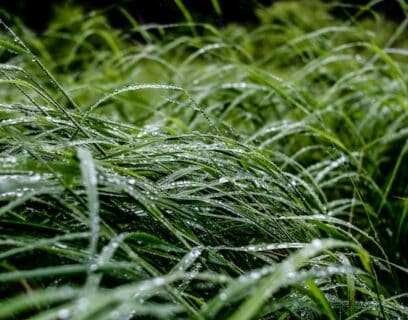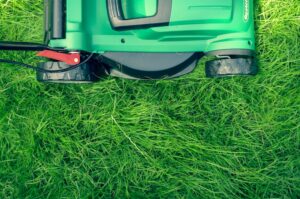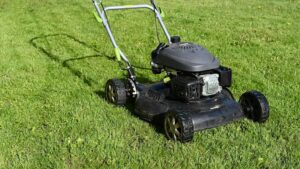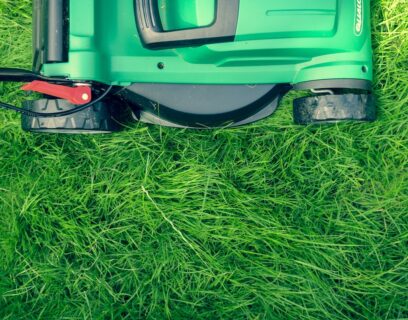Log in or create new account to save this product to your wishlist.
Lawn mowing | How and When to Mow your Lawn for the Best Results | 8 Expert Tips
We all know we need to mow our lawn for optimal growth and appearance. But how often? And how short? And how DO you get those classic tennis court stripes?
Latest articles
7 MIN 22 Jul How to keep your lawn in shape this summer 9 MIN 15 Jul Watering Your Garden: 10 Top Tips! 11 MIN 15 Jul Is Your Grass Type Right for your Garden? 11 MIN 10 Sep Create Your Low-Maintenance Garden – Tips and Ideas 11 MIN 08 Sep The Ultimate Guide to Choosing the Perfect Hedges for Your Garden 12 MIN 30 Aug The Top 20 Evergreen Climbers to Transform Your GardenLawn mowing might feel like a chore, but if you want a lawn that you’re proud of, you need to mow. In fact, lawn mowing is probably the most crucial of all regular lawn care tasks.
But there’s an art to effective mowing, and most people don’t really know exactly what they’re doing when they mow their lawns. And that’s why we put this article together – to help you maximise the benefits of mowing your lawn.
When and how often should you mow? What is the ideal cutting height for your grass? Which mower should you use?
We’ve got answers to all of those questions (and more). So, before you get the mower out, stick the kettle on and put your feet up. Here are our eight tips for a beautiful and sleek lawn.
Why is it important to mow your grass?
Chances are, you mow your lawn to make it look tidier. But there’s a range of other benefits that you might not know about.
Each time you cut, the plant releases a growth hormone that helps repair the leaf. This gives the grass plant an energy boost each time you cut, but if you mow incorrectly, you risk damaging your turf.
Here’s why:
Light and oxygen
Your turf needs light and oxygen.
Grass is green because of photosynthesis – an essential chemical process triggered by exposure to sunlight.
But:
In thick, tall grass, it’s only the tips of the grass that access the sunlight – the majority of the blade’s length is shrouded in shadow. So, cutting your grass provides greater access to sunlight for more of the blade.
Lawn mowing offers greater access to oxygen, helping promote growth from the roots.
Therefore, lawn mowing triggers a sequence of beneficial conditions that promote healthy growth, resistance to disease, and minimises the chance for moss and weeds to take over.
Lawn Mowing – When to Mow
When to cut: the million-dollar question.
In general, always mow your lawn when the grass is dry.
Wet grass tears, creating a larger wound on the blade of the plant. This exposes the plant to fungi and disease and compacts the surface of grass, preventing oxygen from reaching the roots. And wet grass sticks to your mower, clogging up the moving parts.
On the other hand, it’s wise to avoid lawn mowing in the midday sun. Make sure it’s not too hot or your grass will dry out and go brown.
The best time to mow is late afternoon when the sun is low in the sky. Your grass will have enough time to recover before nightfall.
How often should you mow your lawn?
No two lawns are the same, which means that there’s no one definitive answer to this particular question. In short, you should mow your lawn as often as it needs cutting.
If your grass grows quickly, then twice a week is good: it will help encourage the strength and resistance of the turf. Remember, the more you mow, the denser your turf will become because the plant grows more at the roots.
But once a week is enough if your grass grows slowly.
Grass grows more quickly in the summer when it’s warmer, so you can reduce the regularity of mowing the lawn in the spring and autumn.
In most cases, you shouldn’t need to mow at all during the winter.
Always remember The 1/3 Rule.
This way, the grass does not lose its vigour.
What is the ideal cutting height for the grass?
Before you rush off and set your cutting blades at their lowest setting, remember The ⅓ Rule: never cut more than a third of the grass’s length; this way, it won’t lose its vigour.
Avoid cutting your grass too short – this is called scalping, and it damages the roots. The ideal cutting height depends on the conditions of your garden, but – in general – anywhere between 2.5cm and 4cm is optimal for most lawns.
Play lawns need a little extra length to maintain their strength and resistance, so if you use your lawn intensively, cut it to around 7cm.
Shaded Lawns
Don’t cut shaded lawns too short.
If your lawn is mainly in the shade, mow it to around 7cm in height, allowing it to absorb more light and produce the nutrients it needs.
If the grass is long
If you’ve left the lawn until it’s very long, make sure you adhere to The ⅓ Rule.
Cut a maximum of one-third of its total length. Cut regularly, reducing the height by 1/3 each time until you reach the optimal height for your garden.
Lawn Mowing for the first time
When you lay new turf, wait at least two weeks before you mow for the first time. This gives the grass plants time to take root, creating a solid foundation for your lawn. Or if you’re growing new grass from seed, leave at least three weeks after seedlings have appeared before you first mow.
Set your mower to the highest setting (adhering to The ⅓ Rule) and gradually lower it over time.
If you’re growing a new lawn from seed (or are overseeding your existing lawn), leave it for at least two weeks after the seeds have germinated before you even consider moving. Leave it for longer if you can to allow the roots to develop fully.
Mow your freshly seeded areas to around 7-8cm for the first month or so when you do start cutting.
How do you mow stripes into your lawn?
We’ve all admired those immaculate stripes across the tennis courts at Wimbledon, and you might have tried – unsuccessfully – to achieve the same effect in your own garden.
With the right equipment, it IS possible to create the striping effect on most lawns. It doesn’t work as well on low-growing, warm-season grasses such as Bermuda grass, but for most British lawns, it’s possible.
You’ll need a cylinder mower with rollers at the front and the back of the cutting cylinder. The front roller is usually grooved, which helps line the grass up for even cutting. The back roller presses the grass down in a single direction.
It’s the rolling action that gives each stripe its apparent variation in colour. The grass, of course, doesn’t actually change colour; it’s just the way the light reflects on the rolled surface that gives the appearance of stripes.
You achieve the stripes by:
- Mowing up the lawn in a straight line.
- Turning the mower.
- Mowing in an adjacent straight line down the lawn.
Et voila: Wimbledon stripes in suburbia.
Mulching or removing grass clippings
Most of us think we should remove grass clippings from the lawn, but – in some cases – it’s better to leave it to mulch.
Mulch is a layer of organic material that sits on the surface of your soil. Grass cuttings make excellent mulch for your lawn but generally require shredding to assist organic breakdown. You can buy a mulching kit for the best results.
The BBC recommends leaving clippings on the lawn in the spring and summer, suggesting that they provide around 30% of the lawn’s nutrient requirements as the clippings decompose. However, they advise removing the clippings at the beginning and the end of the growing season because decomposition takes longer and could suffocate your grass plants (especially in wet conditions).
In the autumn, scatter grass clippings around your plants in their flowerbeds. This insulates the soil and helps maintain moisture. And as the clippings decompose, they provide nutrition for your plants.
Leaving grass clippings on the surface of the lawn means that you don’t have to empty the grass bin of your mower, and it provides an extra layer of protection during the summer.
TOP TIP: Rake fallen leaves from your lawn in the autumn to prevent suffocating your grass. Raking them into your flowerbeds between your plants provides an excellent mulch layer to protect your perennial plants over the winter.
By mulching, you return nutrients to the lawn
Which type of lawn mower should I use?
There’s a surprising range of lawnmowers on the market. They all have their pros and cons, of course. Read on for details.
Hover mowers
Hover mowers have a single blade that spins at speed, creating an air pocket beneath the body of the mower, which causes the whole unit to hover slightly.
Hover mowers are easy to manoeuvre and much less effort than cylinder mowers. As the name suggests, the mower glides over the surface of the lawn and cuts as it goes.
Hover mowers are convenient and quick to use but can’t achieve the classic striping effect (unless the entire mower sits on wheels (with accompanying rollers)).
Most hover mowers are electric, but you can also choose petrol- or battery-powered.
Cylinder mowers
Cylinder mowers contain a reel of spiralised cutting blades. When pushed, the grass is caught between the spiral cylinder and an additional straight cutting blade, making a clean cut (as long as the cutting blades are sharp).
Cylinder mowers are powered by electricity, petrol, diesel, or batteries.
If you want the striping effect on your lawn, use a cylinder mower.
Manual push mower
If you have a smaller lawn, you might consider a manual push mower – a cylinder mower that’s powered by pushing.
This option is far more physically demanding than powered machines, but there are no cables and you don’t need to buy petrol. These machines make very little noise.
Ride-On Mower
Ride-On mowers (sometimes referred to as “riding mowers”) are perfect for large gardens and are great fun to use.
Ride-On mowers tend to have a much wider cutting deck and are capable of excellent striping. These machines are usually petrol-powered, although some are available with car battery-style cells that are rechargeable.
Perfect for large lawns or narrow strips between trees, ride-on mowers are versatile and take a lot of the effort out of mowing the lawn.
Robotic Lawnmower
Robot lawnmowers are the ultimate in convenience, but they come with a hefty price tag. On the other hand, it could be a good investment because you’ll never have to cut your lawn by hand ever again.
Similar in operation to a robot vacuum cleaner, a robot lawnmower navigates its way around the lawn. Some models have weather sensors, GPS navigation, and even smart connectivity (charging itself when it needs it).
You can operate a robot lawnmower from an app on your smartphone.
How do you maintain your lawnmower?
All lawnmowers require regular maintenance to help prolong their life, but also to protect your grass.
Regular oiling of the moving parts helps keep the mower in tip-top condition while sharpening the cutting blades ensures a clean-cut (rather than a tear).
Remove mud and grass clippings after each use and store your mower in a dry place.
Lawn Mowing: 8 tips for a beautiful lawn
TIP 1: Always mow with sharp blades
For a clean-cut, mow your grass with sharp blades. Blunt blades tear the grass, which dries out the plant and leaves the grass blades open to infection and disease.
TIP 2: Mow weekly in the spring and summer
Grass grows faster in the spring and summer. By mowing weekly, you’ll keep your lawn in tip top condition!
TIP 3: Only mow when the grass is dry
Wet grass tears, so ensure that the grass is dry before you mow. This benefits the quality of your grass and is better for your cutting blades.
TIP 4: Do not mow when it is too cold
The best temperature for mowing grass is between 12 and 20 degrees. Mowing when it’s too cold will damage the plant.
TIP 5: Always take The 1/3 rule into account
Cut up to a third of the grass length at a time. This way, the grass retains its vigour.
TIP 6: Mow in different directions
Varying the direction and pattern of cutting each time you mow helps your grass grow straighter and healthier.
TIP 7: Maintain your mower during the winter
Replace the oil, air filter, and spark plugs if your mower has them. Lubricate all moving parts and ensure that the blades are sharpened. This way, your mower is ready for the new mowing season!
TIP 8: Trim the edges of your lawn.
Don’t forget to cut and trim the edges of your lawn for the neatest look. Use a strimmer or a manual edger to cut crisp lines.
Ready to get started? Or do you want more information?
We hope you feel a bit more knowledgeable after reading this article. But you might still have questions.
We love to be helpful, so if you have any questions – whether it’s about this article or anything to do with developing your perfect picture-perfect lawn – get in touch.
Email us at hello@moowy.shop.
We’re looking forward to helping you.
Leave a comment
Your answer will be displayed on the site and the interested party will be notified by email.
Leave a comment
Have a question or want to share your experience? Leave us a comment.
Read more
The best tips and tricks for a lush green lawn
 11 MIN
28 Jul
The Pros and Cons of a Robot Lawnmower
11 MIN
28 Jul
The Pros and Cons of a Robot Lawnmower
 6 MIN
14 May
Can You Cut Wet Grass?
6 MIN
14 May
Can You Cut Wet Grass?
 Scarifying Kit
All products after scarifying | Quickly restores the lawn after scarifying | Outsmart weeds quickly with the use of this kit
From: € 39.99
Scarifying Kit
All products after scarifying | Quickly restores the lawn after scarifying | Outsmart weeds quickly with the use of this kit
From: € 39.99
 Spring Lawn Care Kit
MOOWY’s choice for the spring | Quick recovery of your lawn after winter | A strong lawn prevents weeds
From: € 25.99
Spring Lawn Care Kit
MOOWY’s choice for the spring | Quick recovery of your lawn after winter | A strong lawn prevents weeds
From: € 25.99
 Long Lasting Lawn Fertiliser
Effective for 90 days | See results in 14 days! | Suitable for all types of grass and soil
From: € 13.99
Long Lasting Lawn Fertiliser
Effective for 90 days | See results in 14 days! | Suitable for all types of grass and soil
From: € 13.99
Do you want a lawn calendar?
🌱 All important maintenance moments for your lawn during the year. Leave your email and we will send you the lawn calendar for free.
Enter your email
Receive the lawn calendar in the mail
Enjoy a green lawn all year round!














Comments (0)
There are no comments yet. Well then, what are you waiting for to
Be the first to write your comment!inaugurate this pretty page?
Do you have some comments?